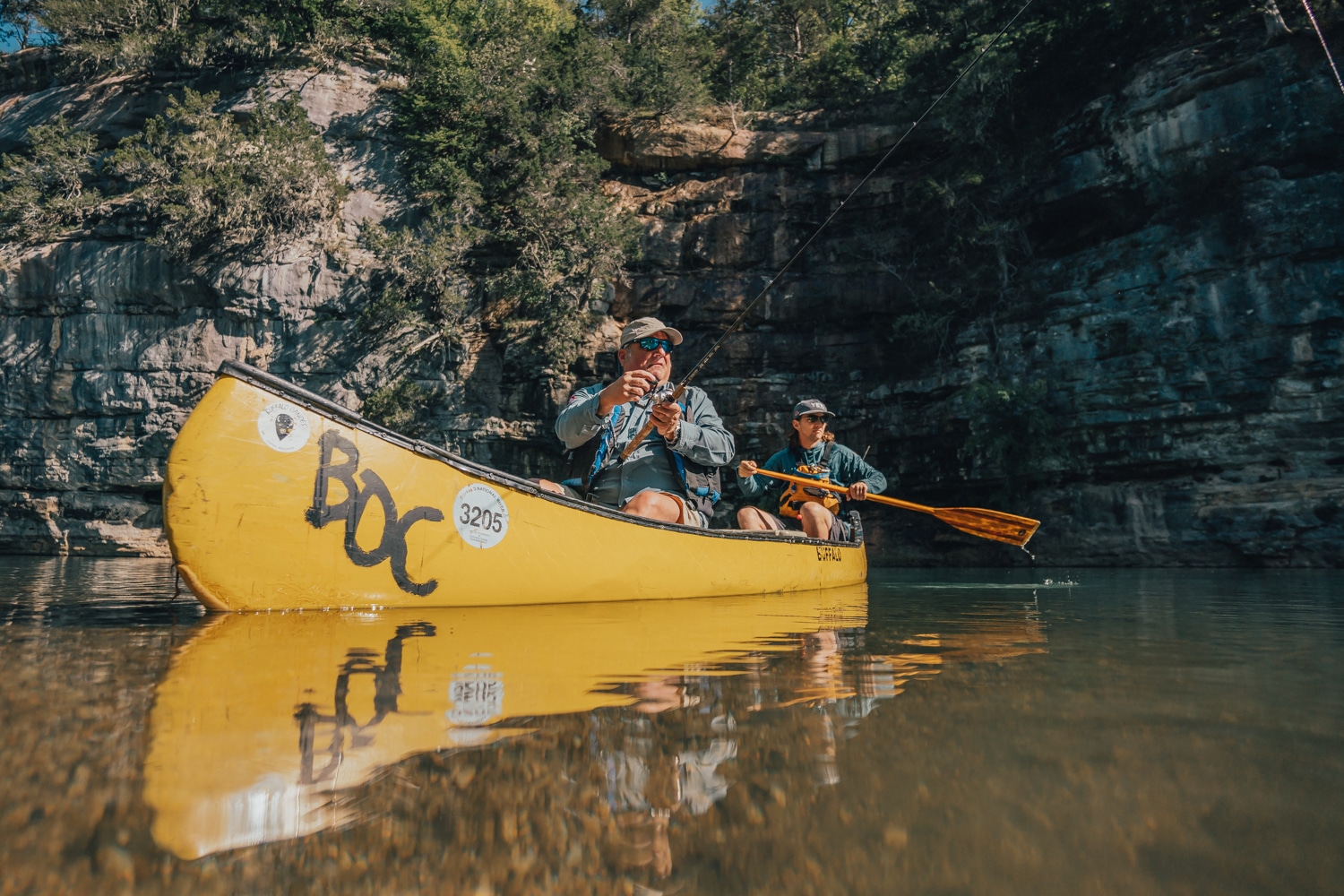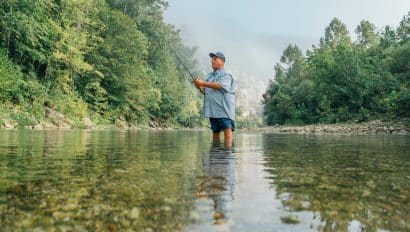Top Ten Lures for Spring Smallmouth Fishing on the Buffalo National River
April 19, 2023Spring has once again returned to the Buffalo National River and Ozark Mountains. Native wildflowers are gracing the Buffalo’s hiking trails and waterfall areas with their beautiful blooms. Whitetail deer and elk have shed their antlers and are already growing new ones for the coming year. Spring is definitely in the air around Ponca, which means IT’S TIME FOR THE SMALLMOUTH BASS SPAWN and my “Top Ten Spring Smallmouth Fishing Lures” for the Buffalo National River!
But first, let’s talk just a little bit about what’s going on beneath the river’s surface and in the minds of the smallmouth. Knowing this helps you better understand why these lures work, which enhances your ability to reel in fish.
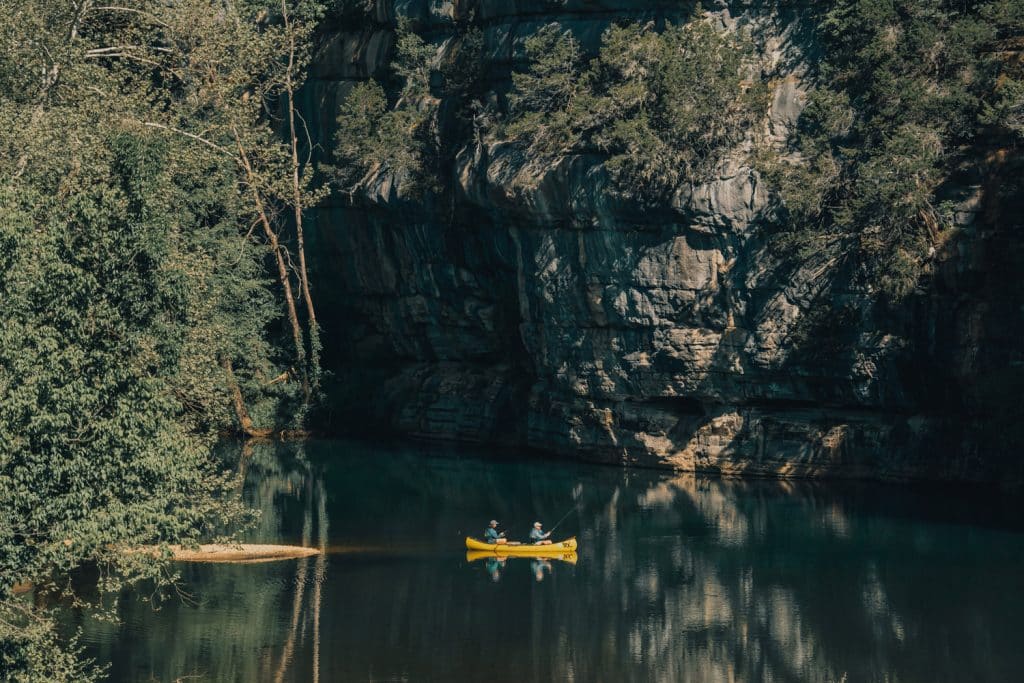
Aquatic Amore
Smallmouth bass normally spawn when the water temperature reaches 60 to 70 degrees. This is just about the same time as largemouth bass. This typically occurs from late April to early June, depending upon whether or not we are having a cooler or warmer than average spring. I have seen smallmouths on their nests as early as the first week of April. However, typically that is not the case.
Smallmouth and largemouth bass make their nests in sheltered eddies off the main channel where the bottom consists of fine pea-sized gravel. The male builds the nest by fanning the gravel with the bottom of the tail fin creating a large depression or “bowl” shape in the river bottom. This is why bass choose the fine gravel as it is easier for them to manipulate. The spawning beds can range in size from 14” to 30” in diameter. After spawning takes place, the female departs the nest and the male remains to guard the eggs until they hatch. Building the nest damages the bottom of the male’s tailfin leaving it bloody and sometimes partially worn off. If you catch a bass with a bloody tail, please release it immediately where you caught it so it can return to the nest and continue guarding the eggs.
No “Dads” for Breakfast
When smallmouth bass begin their pre-spawn feeding cycle in early spring, crawdads are still in hibernation. Crawfish spend the winter months burrowed in muddy banks and do not emerge until late spring. This forces smallmouths to focus almost totally on baitfish as their main source of food. I have caught pre-spawn smallmouths that regurgitated baitfish when I was releasing them. The entire process of spawning takes a huge physical toll on the fish.
Building the nest, for example, is extremely physically tasking. However, that is just the beginning: next comes roaming in search of a female to bring back to the nest. Once they have spawned, the male cannot leave the nest in order to feed or risk losing the eggs to predators or other basses. That is why smallmouth bass are aggressive and feed so voraciously in spring, as doing so builds up their strength and stamina for the long haul.
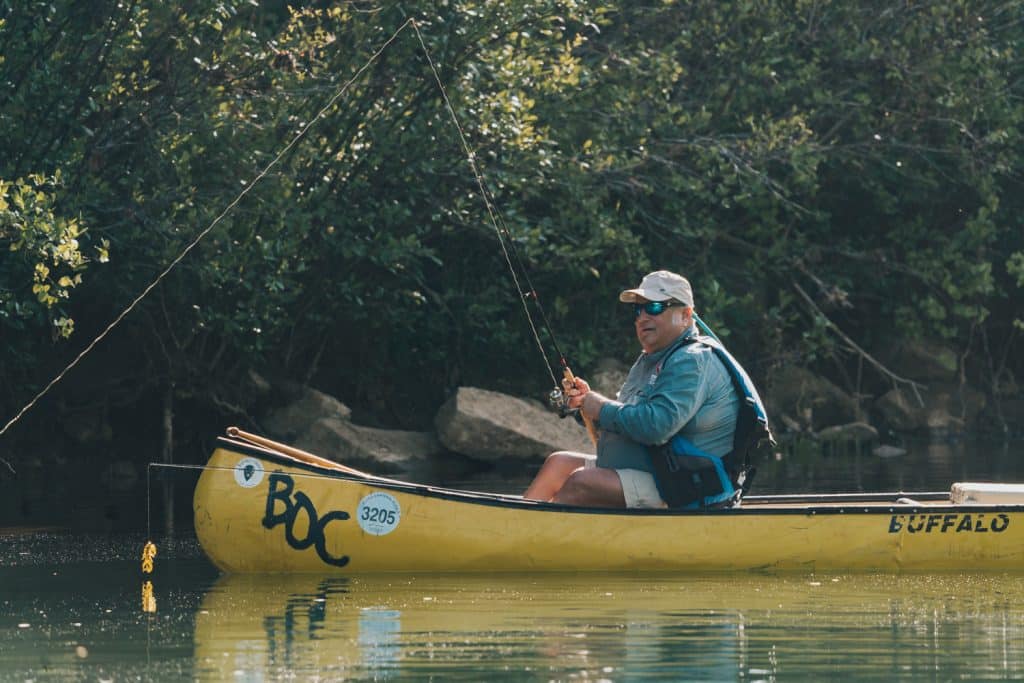
Tony’s Top Smallmouth Lures for Spring Fishing
So, now that you’re armed with some of the “who/what/why,” let’s talk about some of my favorite lures that will help you take advantage of spring smallmouth behaviors.
1. Tube Baits
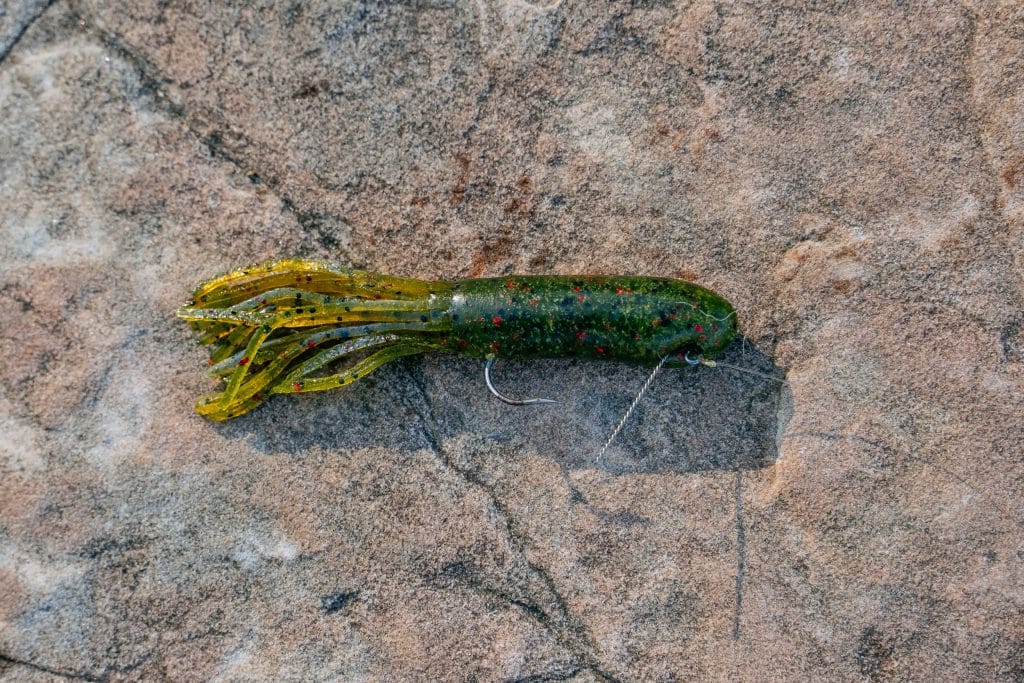
A tube, sometimes called a “Gitzit,” is a soft, plastic lure that mimics a dying or injured baitfish. The tube bait is a cylindrical, hollow soft plastic tube with a closed rounded head and a tentacle-covered open end. They actually kind of resemble a squid without a pointed head. By their description, tube baits sound a bit complicated, however, they are almost as simple in design as a plastic worm. A tube in the 3” to 4” size is ideal for river smallmouth. They can be rigged in several configurations.
I prefer to use an internal tube jig head which puts the weight inside the tube itself. This rigging allows for a more erratic behavior as it flutters to the bottom. Foraging smallmouths cannot resist a baitfish in distress. Cast tubes into eddies or around boulders and sunken trees. Let it flutter down around cover. Retrieve the tube with a gentle lift of the rod tip, reel up some line slack, and let the lure flutter down to the river bottom again. If you’re in a canoe or kayak, hover your boat near cover (such as a boulder or log) and vertically jig the tube around the submerged object. The best colors for springtime are green pumpkin, pumpkin pepper, watermelon seed or shad colors such as pearlescent and silver-n-black sparkle.
Recommended Tackle:
- Spinning Rod 6’-7’ (Fast/Medium Action)
- Spinning Reel
- 8-lb test line
2. Single-Tail Grub
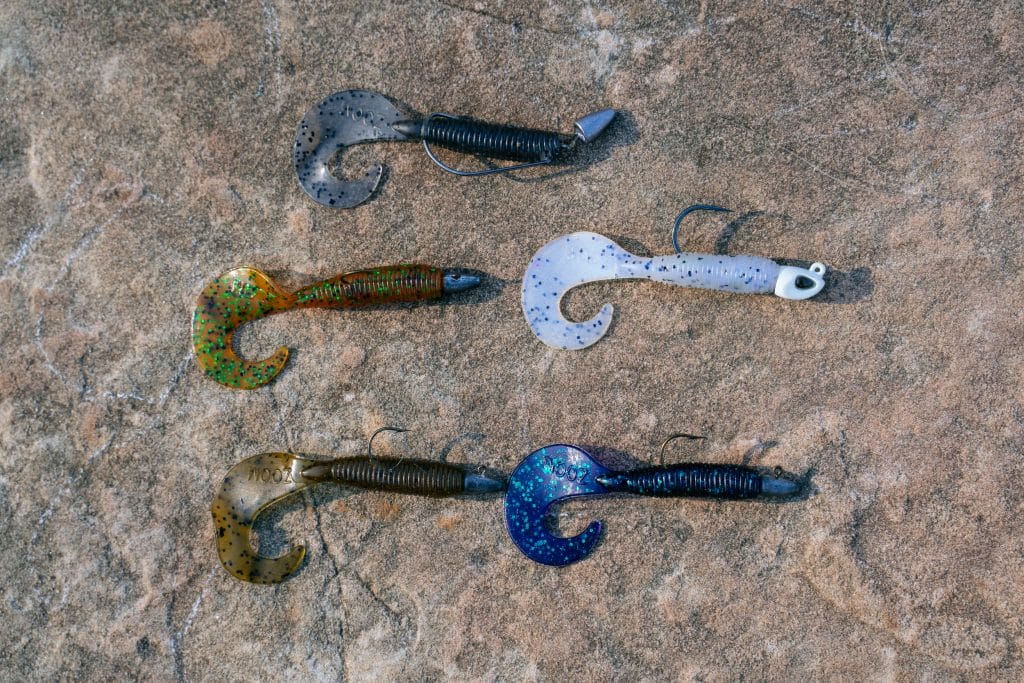
The single-tail grub is one of the oldest and most versatile of all the soft plastic lures. This bait can be rigged in many different configurations. I prefer using a 1/8- or ¼-oz darter-style jig head. The single tail grub mainly imitates baitfish. However, it can resemble tadpoles and other river creatures. Areas to target are boulders, logs or drop-offs where rapids run into deep pools or at the end of the pool where the river begins to get shallow again approaching the next rapid. The most effective way to fish the grub is to cast upstream and retrieve it by bouncing it along the bottom downstream.
The best colors are root beer/green flake, green pumpkin/pepper, watermelon seed or shad colors, shades of pearlescent, silver or silver and black sparkle.
Recommended Tackle:
- Spinning Rod 6’-7’ (Fast/Medium Action)
- Spinning Reel
- 8-lb test line
3. Crankbaits
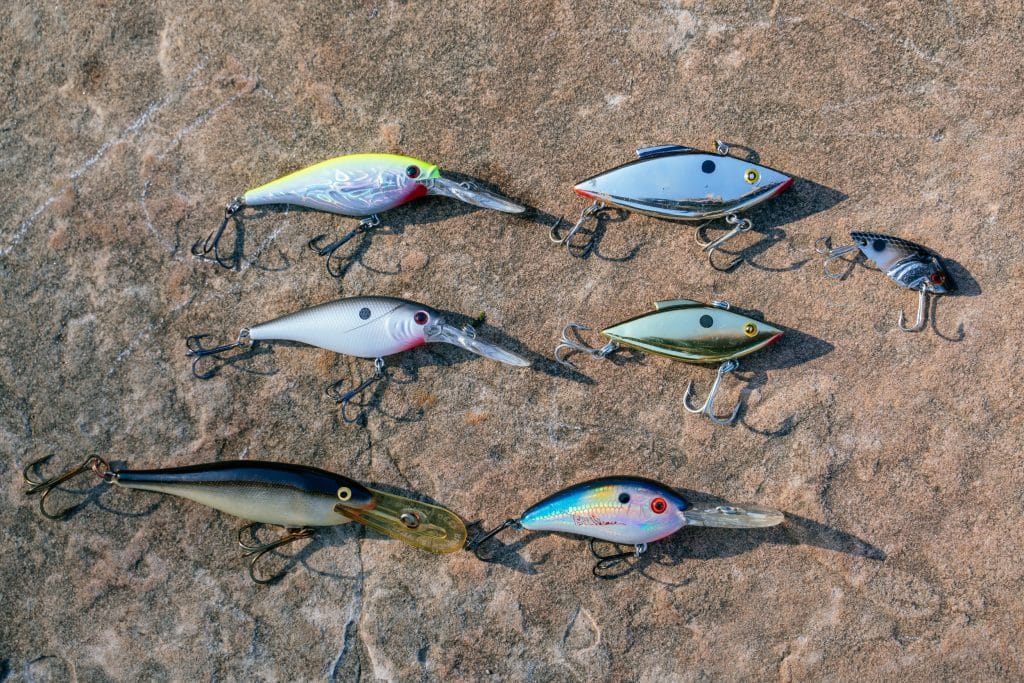
Crankbaits have been a tackle box staple since the 1920’s. Originally made of wood, most modern crankbaits are made of hard plastic. Some even having hollow chambers filled with BB’s or small ball bearings which make a rattling sound under water that attracts fish. Basically, a crankbait is molded in the shape of a baitfish or sometimes a crawfish. There are usually two, sometimes three treble hooks hanging beneath the lure. There is a downward-angled bill (much like a duck’s bill) protruding from the front of the lure sometimes called the lip. As the lure is retrieved, the bill or lip causes the bait to wiggle and dive down into the water. When the retrieve is stopped, the lure floats back to the surface.
Suspending crankbaits will remain at the depth they dove to when the retrieve is stopped. There are also what are known as “lipless” crankbaits. The most popular one is the Rat-L-Trap. Lipless crankbaits begin sinking immediately as soon as they’re in the water like a hard swimbait. You simply retrieve them like a spinnerbait.
Much like a grub, the best way fish a crankbait is to cast upstream and crank it back downstream. You can also crank around boulders and logs. Sometimes cranking perpendicular across the river from bank to the opposing bank will trigger strikes from wary fish.
The best colors are shad and baitfish colors. My favorite color pattern is black back/silver, chrome or gray sides.
Recommended Tackle:
- Spinning Rod 6’-7-‘ (Fast/Medium Action)
- Spinning Reel
- 8- or 10-lb test line
4. Spinnerbaits
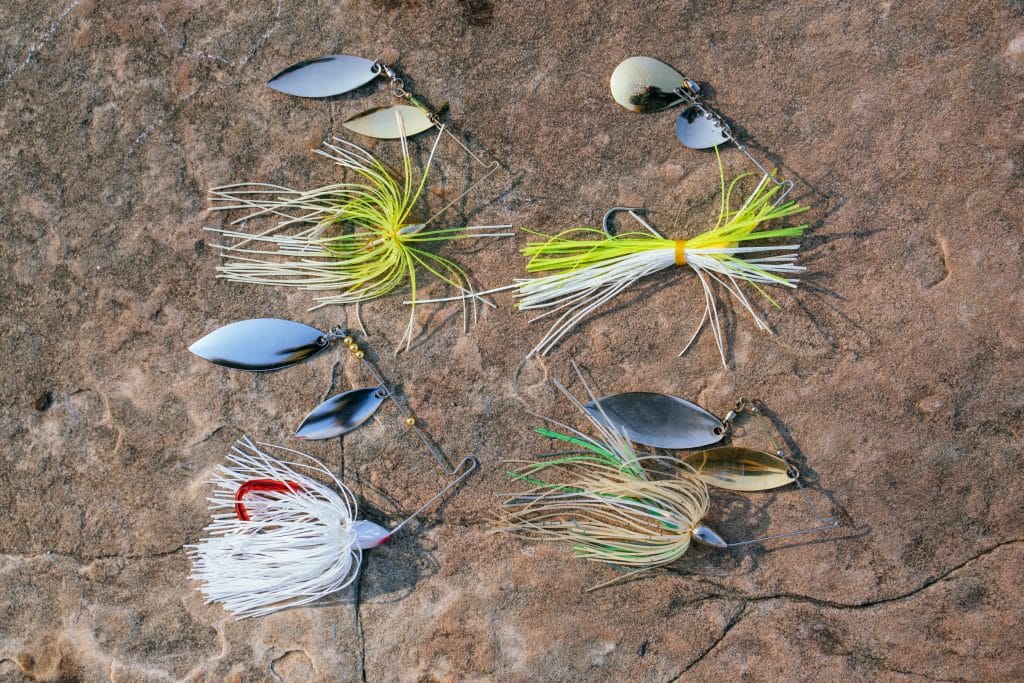
Spinnerbaits have been around since the early sixties. Basically, a spinnerbait is a lead head molded onto a hook with an elbowed wire forming an arm. This “arm” has a metal blade (or multiple blades) attached, which rotate when the lure is retrieved. This creates a flash as well as a throbbing vibration which attracts fish. There is also a silicon hula skirt attached behind the head which shrouds the hook and gives the appearance of a fish body. There are different blade shapes: some are teardrop shaped, some are willow leaf shaped. I prefer the willow leaf blades as they are shaped like an actual baitfish.
This lure is retrieved much in the same manner as a crankbait. You do not bounce it along the bottom. Cast upstream and keep reeling with a steady retrieve. Sometimes the bass like a fast retrieve but usually a moderate pace is more productive. Unlike a crankbait, if you stop reeling in a spinnerbait, it will sink to the bottom.
Spinnerbaits are most effective in cloudy to stained water. This time of year the water conditions can change rapidly due to active springtime weather patterns. The river may be clear one day and stained the next. This makes the spinnerbait an excellent “go to” if the water clarity isn’t great. If the water is clear, spinnerbaits can actually “spook” the bass so I do not suggest using them in clear water. However, they would be good in clear water during low light or at night.
The silicon skirts of spinnerbaits come in a wide variety of colors. However, once again, I prefer shad or baitfish colors.
Recommended Tackle:
- Casting Rod 6’-7’ (Fast/Medium Action)
- Baitcast Reel
- 10- or 15-lb test line
5. Soft Plastic Lizard
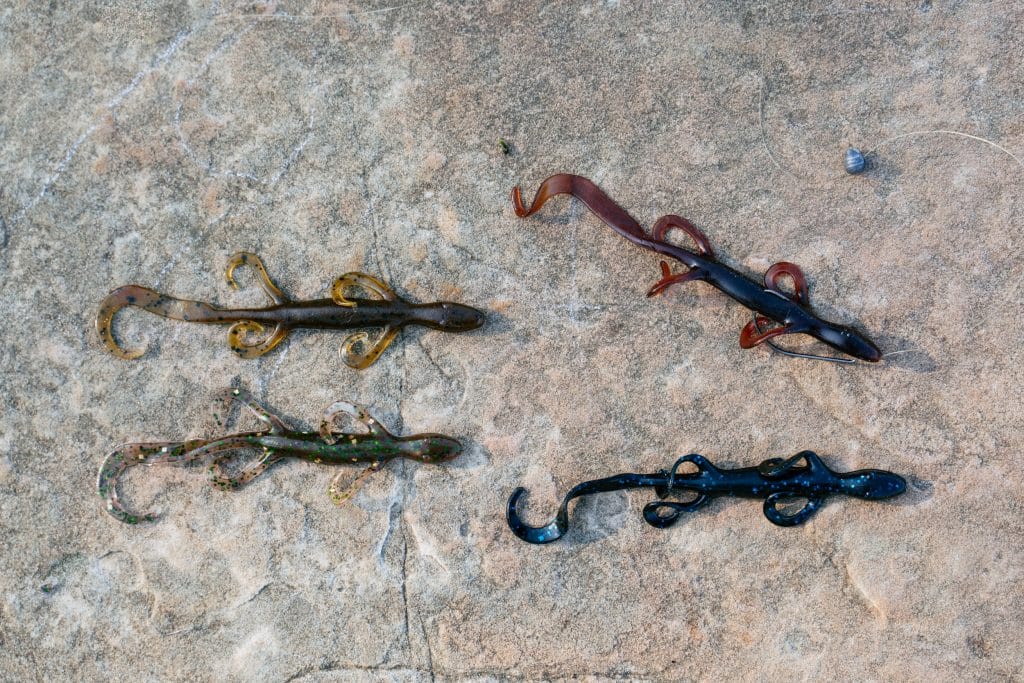
One of the biggest natural threats to smallmouth bass or any bass eggs are salamanders and lizards. Salamanders and lizards will often raid bass nests to get to the eggs. Bass, both smallmouth and largemouth, seem to be genetically programmed to be on the amphibian/reptile offensive. When you get a strike on a soft plastic lizard, trust me, YOU WILL KNOW IT! The bite is not a subtle “tap tap,” it is a ferocious jolt much like someone striking your fishing rod with a golf club! Most often when a bass is guarding a nest, they will rarely strike a lure. Sometimes while sight fishing, I have seen a bass gingerly pick my lure up with its mouth, swim to the edge of the nest and drop the lure outside of the bed. However, toss a lizard in there and hang on!
Plastic lizards can be rigged several different ways. I’ve seen them rigged on stand-up jig heads. Personally, I like to use what is called a California Rig. A California rig simply is a scaled back “finesse” version of the ever-popular Carolina rig. This rig consist of a 2/0 offset worm hook and a 1/8 oz to ¼ oz split shot weight crimped on the line about 12” up from the hook. Like the Carolina rig, the California rig allows the lizard to float above the bottom in plain sight of foraging bass. The California rig was developed by tournament anglers targeting spotted bass or “Kentuckies” in the clear impoundments of southern California.
The best lizard colors are pumpkin/pepper, watermelon seed, junebug or any colors involving black or brown as those are natural salamander colors.
Recommended Tackle:
- Spinning Rod 6’-7’ (Fast/Medium Action)
- Spinning Reel
- 8-lb test line
6. Soft Plastic Jerkbait
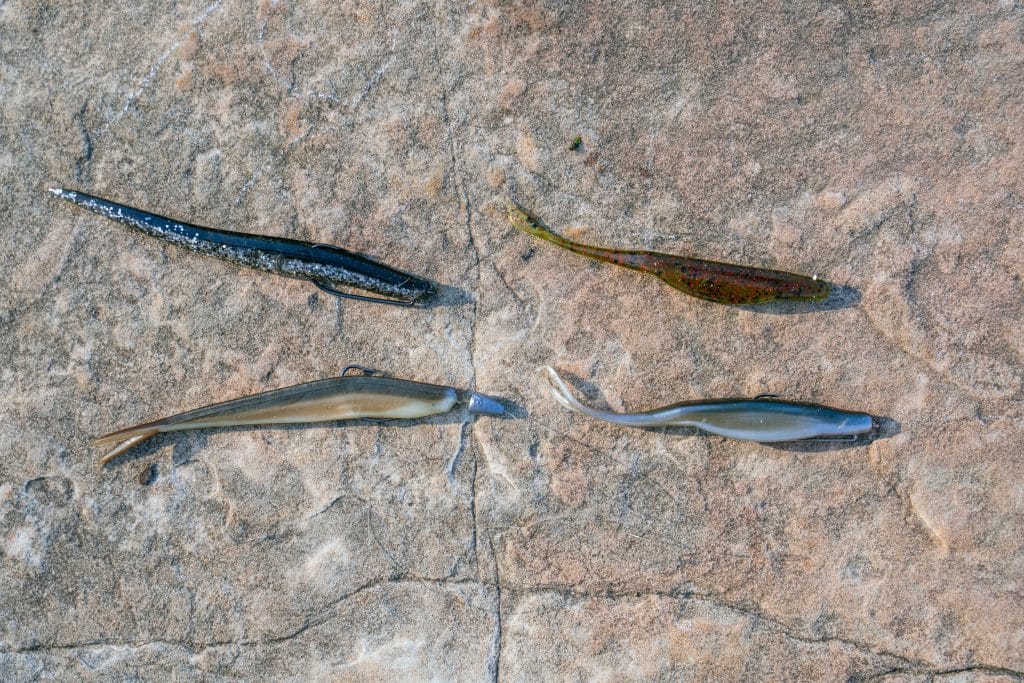
Soft jerkbaits became the bass fishing rage during the early 1990’s. This rig is about as easy as fishing can get. The lure is nothing more than a soft plastic minnow body. Some have tailfins others are simply cigar shaped. Plastic jerkbaits are usually fished without a weight. Like a tubebait, they dart erratically and flutter when “jerked,” hence the name. And, also like a tube bait, they mimic an injured or dying baitfish. Sometimes when fishing a lake, a weight is added to get the lure down to suspended largemouth bass. However, for river purposes, a weight is not necessary. Places to target are eddies with boulders or sunken trees. Or, simply jerk perpendicular across the main channel. Rig this lure with a 2/0 or 3/0 offset worm hook.
The best colors are natural shad colors. There is one particular brand called a “Slug-go” which offers a color called “Arkansas Shiner.” The back is dark olive and the sides and belly are silvery gray. I’ve seen many bass caught during the month of April using a soft jerkbait.
Recommended Tackle:
- Spinning Rod 6’-7’ (Fast/Medium Action)
- Spinning Reel
- 8- or 10-lb test line
7. Swimbaits
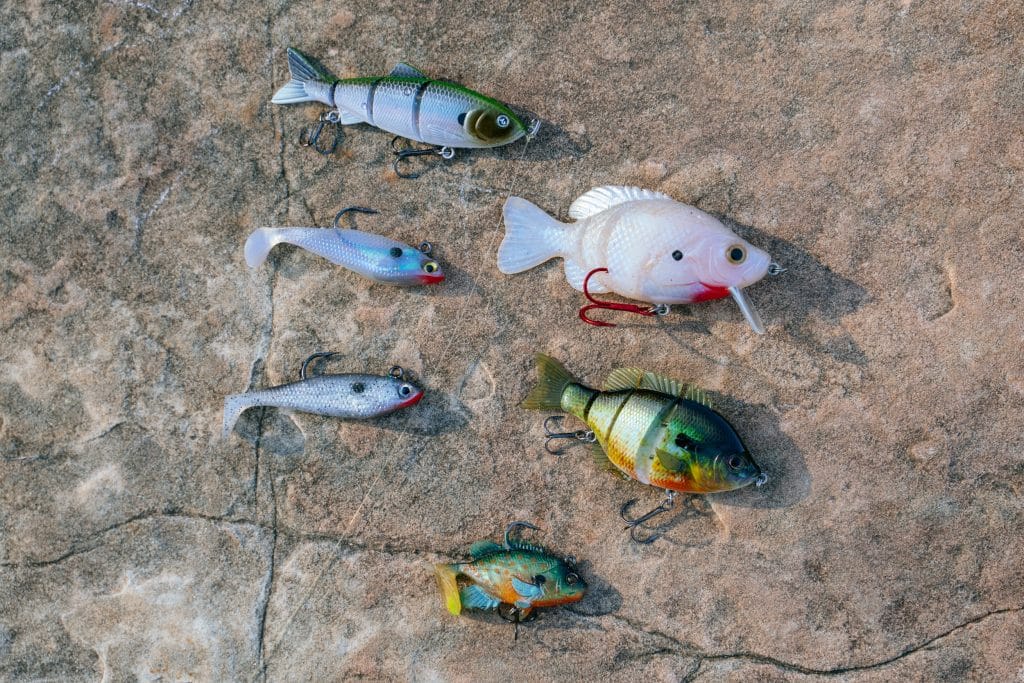
Swimbaits are a class of fishing lures designed to primarily imitate the underwater swimming motions of baitfish. These lures originated late in the 1980’ / early 90’s as lures designed to imitate the rainbow trout in Southern California reservoirs that trophy largemouth bass and striped bass were feeding on. There are two categories of swimbait: hard-body and soft-body. The hard-bodies are jointed or hinged so that the body makes a natural swimming motion when retrieved. Hard-bodies are also very realistic looking because they can be painted with high detail to resemble an actual baitfish. Hard-bodied swimbaits require no weights as they are heavy enough to sink on their own. Soft-bodies usually come with the weight and hook built-in from the factory.
Swimbaits are very easy lures to work. Simply cast the lure and retrieve. The swimbait does all of the work itself. Cast upstream and retrieve downstream. Cast to an eddy and retrieve. Let it dive down around boulders or logs. The best colors are shad patterns and actually game fish. Smallmouth and largemouth bass both love to eat long ear sunfish, so these are ideal baits for spring fishing.
Recommended Tackle:
Hard-Body Swimbait
Casting Rod 6’-7’ (Fast/Medium Action)
Baitcast Reel
10- or 15-lb test line
Soft-Body Swimbait 3”-4”
Spinning Rod 6’-7’ (Fast/Medium Action)
Spinning Reel
8- or 10-lb test line
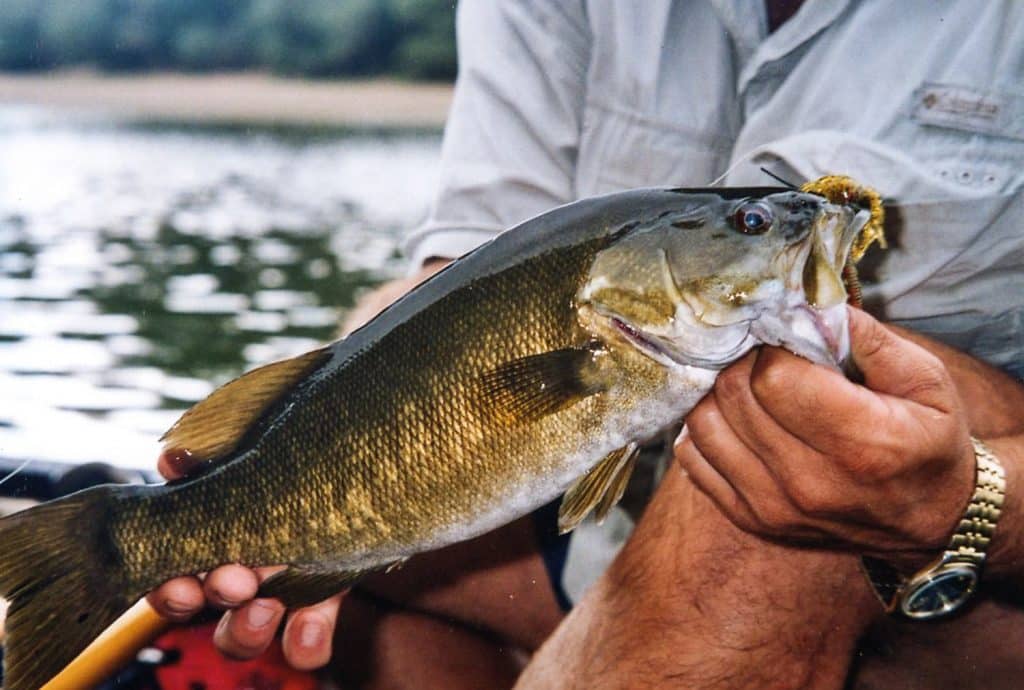
Flying High: 3 Top Lures for Spring Fly Fishing
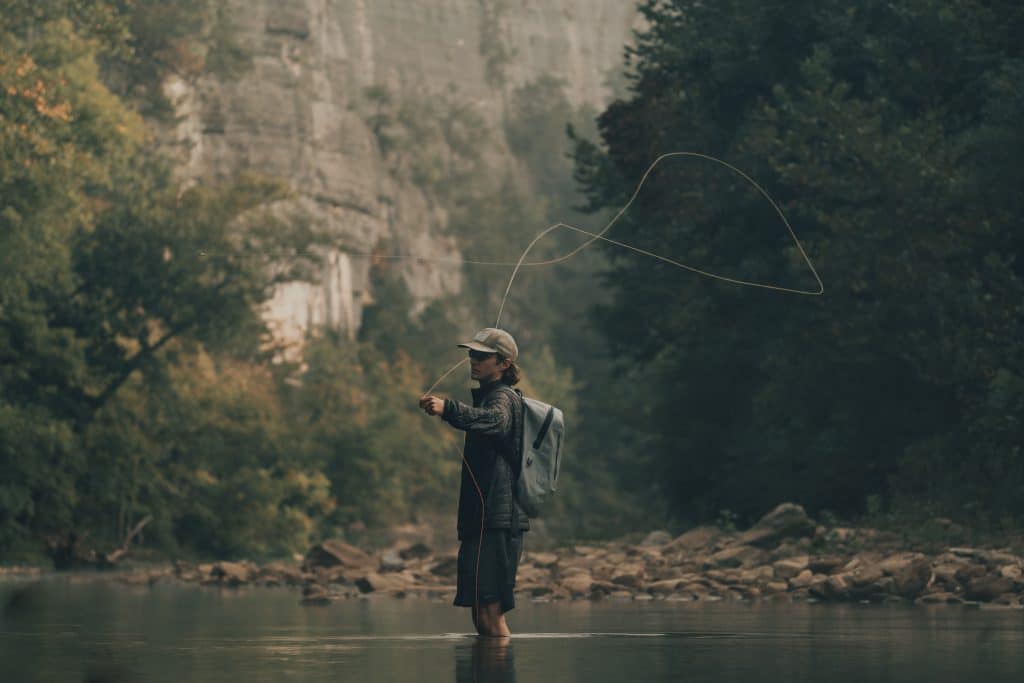
Never fear fly guys and gals, you have not been forgotten. Fly fishing for smallmouth bass is becoming more and more popular, especially among millennial anglers. Each float season I see plenty of fly rods being loaded into canoes and kayaks. So, as in our last fishing blog on fall fishing, we wanted to be sure and include selections for the fly enthusiasts who wish to challenge the “wiley” smallmouth. Buffalo Outdoor Center’s fly fishing expert Brodee Graham is going to finish out our top-ten list with his personal favorites for spring bronzebacks.
8. Chocklett’s Mini Changer Fly
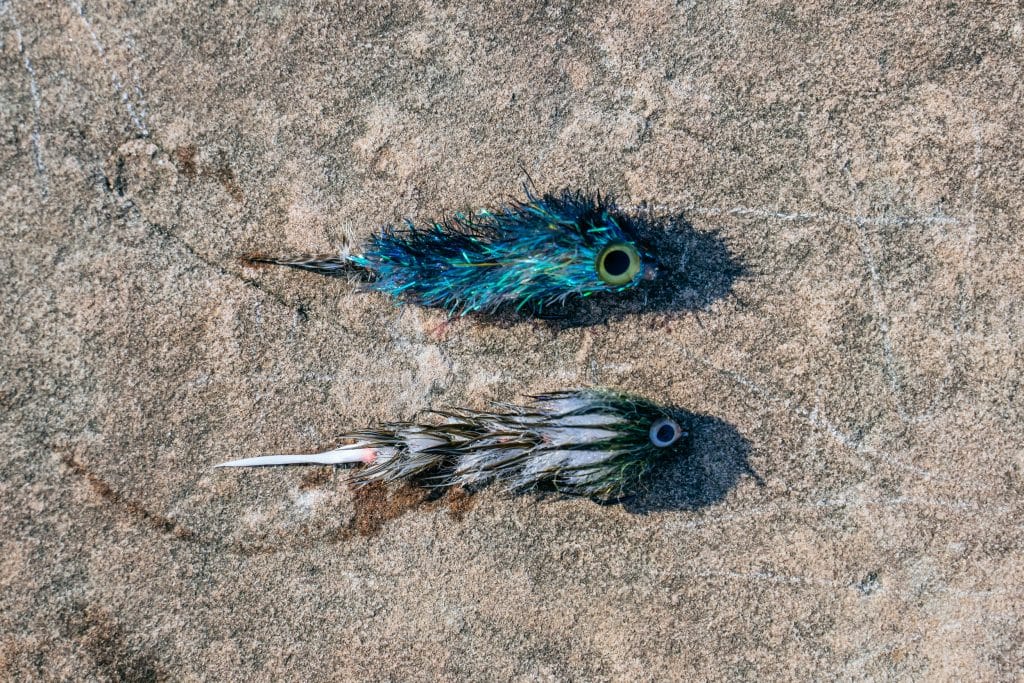
The Mini Finesse Changer fly is a smaller version of the realistic small scale baitfish streamer the Finesse Game Changer. Like the Finesse Game Changer, the Mini Finesse Changer is a six-segment fly built upon an “articulated fish spine,” which gives it a very realistic baitfish swimming motion. You might say that it is a fly angler’s version of a swimbait. (Hard- and soft-plastic swimbaits were previously discussed in this blog.) The Mini Changer Fly is one of Brodee’s favorite new additions to his flybox.
Swim this streamer around boulders and sunken trees. Or, simply swim it in the main channel and let the river current activate its natural swimming motion. The best colors are white, tan, tan/olive and purple/black. Purple/black would be excellent in low-light conditions, after dark or in stained or muddy water.
Recommended Tackle:
- TFO LK Legacy 9’ fast action 6-weight fly rod
- Ross Animas 5/6 weight fly reel
- Aiflo streamer max short fly line
9. Murdich Minnow
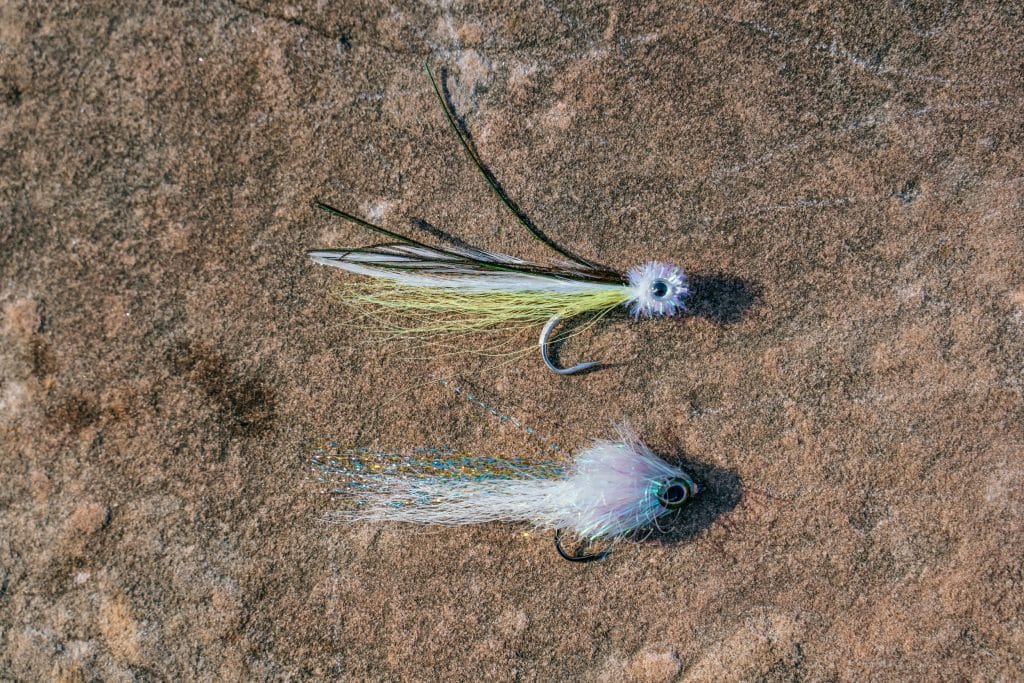
The Murdich Minnow originated as a fly pattern for striped bass. However, it has proven itself as an incredible freshwater fly for catching smallmouth and largemouth bass! With a perfectly neutral buoyancy, this streamer will dart and hang in the strike zone, making it irresistible to any predator fish preying on baitfish. Fished on either a floating line, a sinking line or an intermediate line, the Murdich Minnow will tempt even the wariest of smallmouth bass. Fish it around boulders and sunken trees or parallel along bluff lines. The Murdich Minnow is an excellent choice for pre-spawn smallmouths as this is when bronzebacks are targeting baitfish. The best color pattern for river smallies is white/gray.
Recommended Tackle:
- TFO LK Legacy 9’ fast-action 6 weight fly rod
- Ross Animas 5/6 weight fly reel
- Airflo streamer max short fly line
10. Clouser Minnow
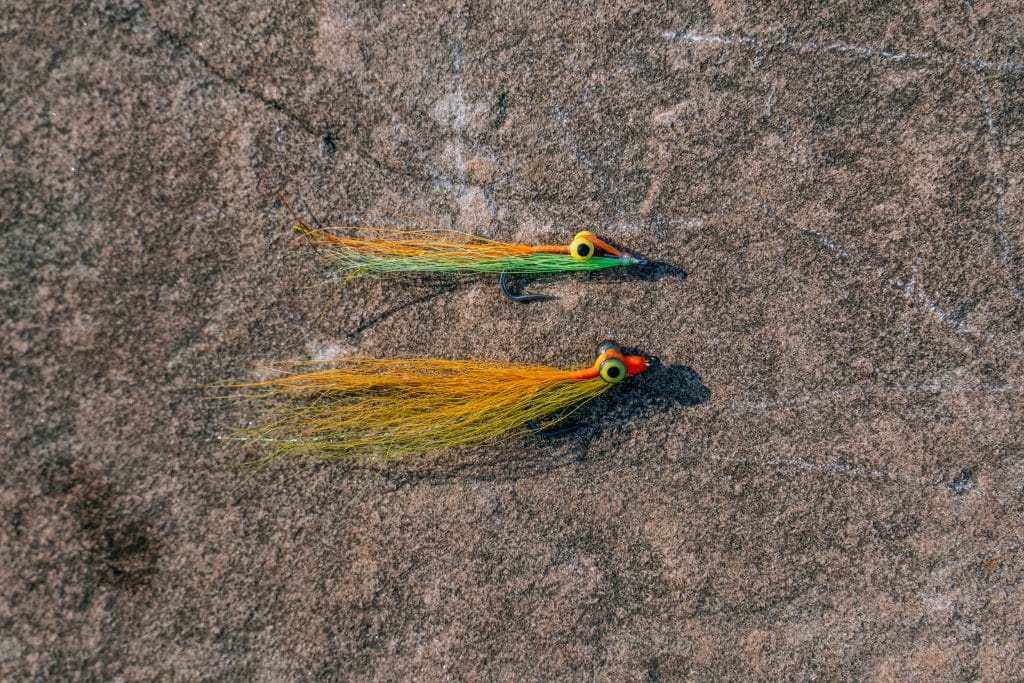
The Clouser Minnow is one of the most popular flies of all time and should be a standard in any flybox. This streamer evolved from traditional bucktail streamers and was created in 1987 by Bob Clouser, a Pennsylvania fly shop owner and guide. The original patterns were intended to be used for smallmouth bass on the Susquehanna River. The Clouser Minnow imitates a baitfish and there are many variations intended to imitate very specific baitfish in different fresh and saltwater situations. Fish this streamer in eddies around boulders and sunken trees or parallel along bluff lines. Chartreuse and white is always a good color. However, other great colors are olive/white, gray/white and bue/white.
Recommended Tackle:
- TFO Axiom II 9’ fast-action fly rod
- TFO BVK 5/6 weight fly reel
- Airflo power taper floating fly line
Be Prepared for Spring Weather
Yes, springtime on the Buffalo River has returned, that is for sure. The days are growing longer with each sunrise and sunset. However, do not let yourself be fooled by Mother Nature as we are still experiencing the exodus of Old Man Winter. One day might be sunny with a daytime temperature in the 70’s. But let a front move through and the next day could be in the mid-40’s with overnight lows below freezing. So, DRESS IN LAYERS if you plan to be on the river in the spring. This way you can shed or add clothing as temperatures fluctuate.
Also, this time of year the Buffalo National River water level can be high, which can make wade fishing difficult and possibly unsafe. Be sure to CHECK THE CURRENT BUFFALO RIVER LEVEL before you go fishing. If the river level is high and you DO choose to wade, always wear waders or a wet suit (we rent wet suits in the BOC store). Hypothermia is something that should be taken very seriously. Remember, if the air and water temperature do not add up to 100 degrees, hypothermia can set in very easily if you were to get wet. Be sure to pack not only extra clothing but also warm clothing in case you need to change after getting wet.
Food is also a good way to warm the body, so be sure to pack a good lunch and plenty of protein-rich snacks. We offer a great selection of fresh-made deli sandwiches and breakfast burritos at BOC. These are packaged to be river friendly and ready to eat in your boat or on a gravel bar. My grandfather always packed a thermos of hot coffee to stay warm when fishing in cold weather; filling a thermos with coffee is something that’s also available in our deli.
Plan Your Buffalo River Fishing Adventure Now!
So, there it is: our Top Ten Lures for Spring Smallmouth Fishing on the Buffalo National River. Now, the rest is up to you! Make that plan for Ponca and let us know how we can help. Here’s a handy link to our canoe and cabin rental pages should you need a boat or lodging for your fishing adventure.
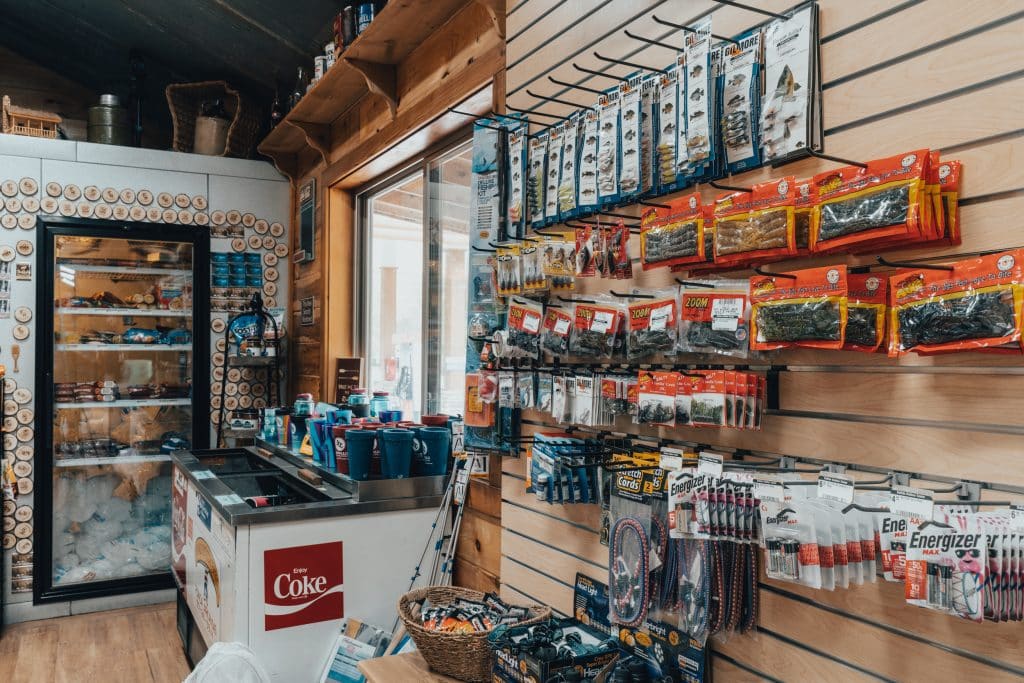
Need Lures?
The BOC store in Ponca is stocked with several varieties of the lures written about in this blog post, including lizards, tube baits, jerkbaits, fishing line, hooks, jigheads and more. Grabe some lures, a sack lunch from the deli and you’re ready to fish! As always, be safe and good luck fishing!
About the Author: Tony Harlan, also known as “Mr. ExStream,” grew up fishing the streams, rivers and lakes of northwest Arkansas, southwest Missouri and southeast Oklahoma. When he’s not holding a fishing rod in his hand, in the summer you’ll oftentimes find him snorkeling at a local swimming hole near Ponca, hand-feeding worms to the perch and bass who live there. Tony has been with Buffalo Outdoor Center for 10 years and can be found be found many places, including behind the front desk, serving as crew chief for our shuttle crew during canoe season or managing our RV park!
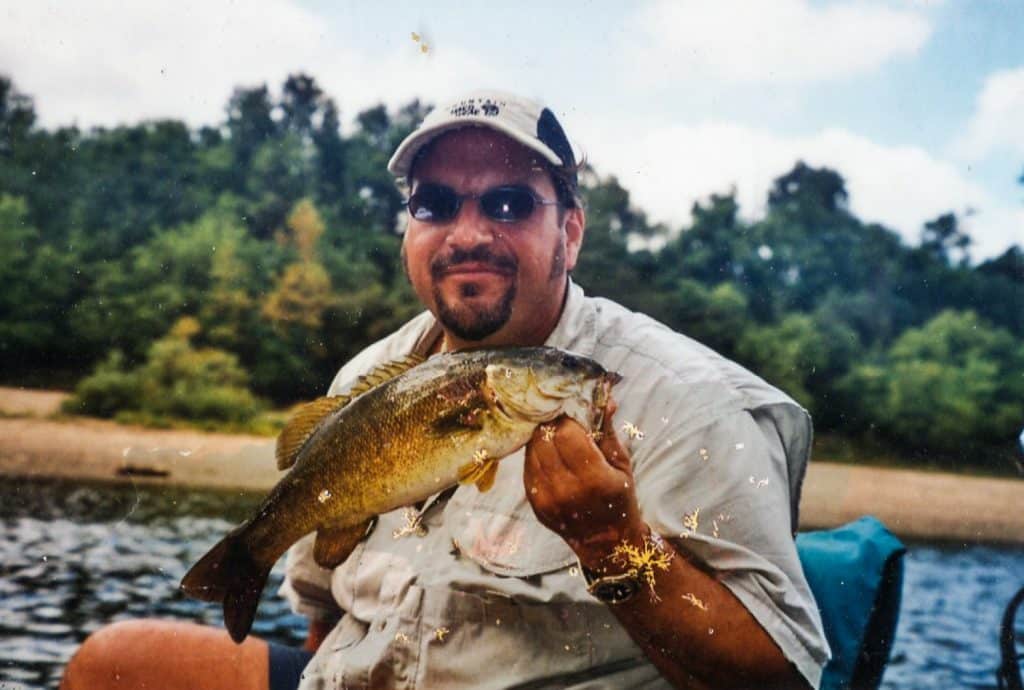
Don’t forget to buy your Arkansas Fishing License online!

